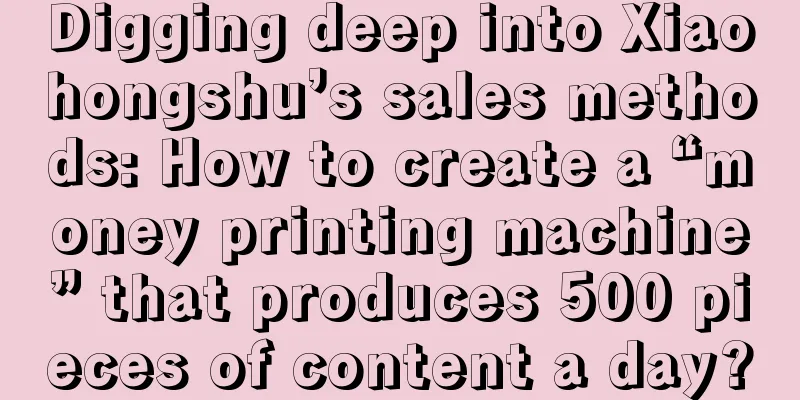Digging deep into Xiaohongshu’s sales methods: How to create a “money printing machine” that produces 500 pieces of content a day?

As Double Eleven approaches, merchants' marketing activities on various platforms have become lively again. Xiaohongshu, as a popular content marketing channel, has once again returned to our attention. We have previously systematically studied the new strategies and trends of Xiaohongshu marketing and found that brands are still generally using the model of seeding to achieve the effect of breaking through the crowd circle and expanding the mind. At the same time, with the help of new systems and tools, many brands have also used Xiaohongshu as a platform for user co-creation to feed back product innovation. However, we are also thinking about a question: According to the current model, creating content on Xiaohongshu will inevitably become a "cost center" rather than a "profit center." In the context of reducing costs and increasing efficiency, are there other types of new strategies on Xiaohongshu that can bring content closer to money? With these questions in mind, I visited an old friend who has been working in the new media industry for many years, and he told me: Xiaohongshu does have a way to make money quietly, where merchants can live comfortably, and the top merchants can reach hundreds of millions of yuan in sales. It is used in many toC industries such as beauty and personal care, clothing, health products, travel, training, and home furnishings. With "bringing goods" as their core goal, they can get traffic that most existing brands cannot access, turning content into a "money-printing machine" for the company. Unlike what I knew before, this gameplay is simple and crude:
This is so interesting that I have to share it with everyone! After a lot of persuasion, I finally got him to explain the logic of this gameplay in detail. First, he reminded everyone that different types of businesses have different dimensions to refer to and learn from, and should not have too high expectations of a "master key": 1. Small and medium-sized businesses, physical businesses, factory transformation and other businesses that cannot invest too much in brand building: This business model is more suitable for copying, which is equivalent to adding an online exposure and traffic channel. It can be implemented even with limited budgets, and the trial and error cost is low. Once the attempt is successful, it will directly generate business income and profits. 2. Businesses that invest a lot of budget in brand building, such as emerging and traditional brands: It is not suitable to directly copy this business model because it is not efficient in accumulating brand assets. What is worth learning is the idea of efficiently producing fragmented content to improve the operation of owned media, empowerment of dealers, private domain operations, etc., thereby increasing the efficiency of content supply and bringing more sales conversion opportunities. When the existing content marketing strategy is saturated, try to open up new increments. Well, if you are also interested, please continue reading. 1. How does the content printing machine work?The entire business operation chain can be roughly divided into two types: Grass-planting mode: After the content is prepared, it is directly sent out through amateurs. Generally, no matrix is built by itself, and the conversion is redirected to Tmall. The cost of entering the store can be kept very low. Since the marketing channel is focused on Xiaohongshu, the input-output is easier to measure. However, the content is released in batches, and it is impossible to attribute the sales to a single content. Private domain model: Build your own matrix of amateurs, prepare the content and publish it yourself. You can choose to release a part of the information flow and guide it to the private domain for conversion. The cost of adding WeChat can be reduced to a very low level. Since adding private domains has a clear data link to track, you can directly connect with the sales team later, and the input-output calculation is very clear, which can be specific to the effect of each account and each content. (There is also an instant conversion model for e-commerce on Xiaohongshu, but it is not the mainstream in the market at present) No matter how the link is designed, the biggest difference from conventional strategies is that the content is 100% produced internally, with no third-party influencers or organizations involved, and no UGC . Brands with more marketing budgets tend to look for professional influencers or organizations to produce and distribute content, rather than producing it in-house, so that they can spend money more efficiently. For example, Xinbang once sorted out the business note data of Xiaohongshu in the first half of 2023. The top 10 brands in terms of advertising expenditures all spent more than 27 million yuan in half a year. Among them, the 10 sub-brands of L'Oreal spent 290 million yuan on business notes in half a year, while the eight brands of Estee Lauder spent 150 million yuan[1]. Such a huge amount of money is actually mainly spent on "buying content" : the bulk of the money is spent on bloggers to let them come up with ideas and content. If the cost of building a content team is much lower than that of bloggers and agents, the marketing rate on Xiaohongshu can be significantly reduced. The business goal is to reduce the cost of attracting new users, and there will be a steady stream of new users. Then, if the efficiency of store operation and conversion in the back-end link remains unchanged, the profit margin will be improved. For example, the traditional method costs 100 yuan to attract a new user to the store, generating 200 yuan of consumption per month, but now it may only cost 10 yuan to get a new user to the store with content, and also generate 200 yuan of consumption. Therefore, the most important thing about this type of gameplay is to have the ability to continuously and low-cost produce popular content, thereby reducing costs and increasing efficiency. Our previous research also found that "it's difficult to create hit content" and "traffic is getting more and more expensive" are no longer limited to Xiaohongshu, but have become the two biggest pain points in the entire social media marketing field. Focusing on Xiaohongshu, "the effect of KOL cooperation is not up to expectations" is another biggest problem. Then the question arises: Why can the "makeshift team" built by the merchants solve the above problems? The secret to turning content into a money-making machine is to "use templates": you don't need to know why the hits are hits, their existence is reasonable. What you need to do is to find the templates of the hits and then repeat their success. The classic operation method follows the "1+4" framework: "1" refers to the prerequisite. Not all categories are suitable for content marketing on Xiaohongshu. Product selection is a mixture of metaphysics and science, and also involves the layout of the company's strategy, so the factors to be considered are very complex. I will not elaborate on this here, but provide two more important reference indicators for this method:
If the main products and selling points have been determined, you can move on to "4" below (note: this strategy only applies to graphic notes!). 2. Find a templateThe so-called template is actually a relatively fixed note format, which includes five components: header image, title, body, hook, and comment . Its features are:
Since it is not convenient for me to reveal other people’s “ways to make money”, I will not talk about the latest templates and routines here. You can try it yourself according to the following aspects. It is not difficult to find ( if necessary, you can also turn to the end of the article and add my friend for a private chat ). Let me give you a typical example: N with 1 grass template , which was often seen in the beauty, personal care, health care and other industries in the past. This type of graphic note will recommend 5 functional products, putting your own products together with other well-known products, but only 4 well-known products are placed in the header picture, and you can only see your own products by sliding. At the same time, a hook is reserved in the text to introduce the functions and selling points of your own products, pre-embed unique product keywords, and leave user feedback (for your own products) in the comment area. Now, the most critical question is: How can we design a template with the potential to be a hit? And how can we build our own template library? According to the idea of market insight, creating Xiaohongshu content is "a priori": first conduct big data research and consumer research, fully explore competitive opportunities, segmented scenarios and other factors, and then guide the production of content to match product selling points. For example, in the official IDEA methodology, Xiaohongshu has also launched a special product "Lingxi" to help brands with data insights. In other words, we need to understand "why hot products can become hot products" in order to continuously design creativity and routines with the help of underlying logic. (Source: Xiaohongshu official) However, finding a template is a completely different idea. Instead of dwelling too much on the reasons for a hit, we can use the results to speak for ourselves: we only need to know which type of content is more likely to be recommended by the algorithm and thus have a chance to become a hit. No matter how rich the data we get, we can't 100% restore the reason why a piece of content becomes a hit. After all, the recommendation algorithm is still a black box most of the time - just like the developers of chatgpt themselves don't know why chatgpt answered this way. Therefore, we don't use any data, but manually "tune" the algorithm to let the algorithm tell us which relevant content will be recommended to the homepage, and we use the most suitable one as a template. (Note: The advantages and disadvantages of different methods are not compared here. Each method has its own applicable business scenarios. The following is just a reference idea.) The first step is to find enough relevant content. Instead of using big data tools to capture, use your own account to manually swipe and search.
The second step is to filter out the notes that meet the requirements and like and collect them. Graphic notes with the following characteristics are more worthy of our attention:
When you see this kind of content, first record it, then like and collect it, so that the algorithm can fully understand the topic area we are focusing on, such as "acne scar removal". The third step is to clear out irrelevant recommendation notes. If we use our own account and repeat the above two steps, we can fully observe what kind of content is recommended by the algorithm and what kind of content can become a hit. This will make the homepage recommendation information flow an accurate "template library" - some niche needs and high-quality hit content will continue to appear on the Xiaohongshu homepage . For example, after a lot of interaction with notes related to "acne scar removal", almost all the notes recommended on the homepage focus on topics related to acne removal and meet multiple characteristics of the second step. The next thing to do is to find the notes that do not meet the requirements from the recommendation flow (for example, an occasional note related to "new house decoration"), and click "Not Interested" , so that the algorithm deviation will become smaller and smaller. Eventually, you can continuously fish for hot items from this content "fish pond" as templates. The requirements for selecting templates vary from industry to industry, but repeated appearance, latest release, low number of fans and high likes are necessary prerequisites. For mature merchants, there will be a full-time team to complete the accumulation of this content pool: the daily work is to constantly browse Xiaohongshu, and SOP and template screening standards have been established. It should be noted that the content team must practice for a long time to get a feel for the physical and online aspects in order to improve the hit rate of the popular templates. It is not something that can be done easily. For example, after I trained on the topic of "acne scar removal", I thought I found a template with the matching characteristics of "handwriting". However, my experienced friends told me that this template is outdated, has little appeal to users, and may not have ideal conversion effects. 3. Create contentAssuming we have successfully locked in a template, what is the next step to turn it into 1 or even 100 new notes that bring us products? The template is equivalent to building a skeleton for us, and the flesh and blood still need to be filled in by ourselves according to the actual situation. Picasso once said: Good artists copy, great artists steal. Excellent content creators have the ability to give new meanings and connotations to the things they imitate, making these elements serve their own works. It is highly unlikely that copying the successful notes of competitors will work. In addition, the templates we continue to develop in the content pool are not necessarily promotional notes produced by peers. They may be non-commercial notes written by users themselves, without any attributes of promoting products. After adjustment and modification, they can still be used as promotional templates. For specific practices, we need to refer to the two principles in "The Generation of Ideas" by advertising master James Webb Young. First of all, creativity comes from new combinations of old elements. When we find a potential template, we need to identify the key elements contained in the five modules: header image, title, body, hook, and comment. Since we want to combine, we should always know what we have at hand. Secondly, we need to understand the relationship between things in order to successfully combine them. We must be able to distinguish between variable elements and immutable elements. Immutable elements are the basis of the template, and once they are changed, they will have no effect; variable elements can be freely adjusted as parameters to generate new ideas. To distinguish these elements, on the one hand, we need to rely on our daily experience accumulation and actual combat experience, and more importantly, we need to understand the pain points of consumer demand and the motivations and human nature behind them. For example, the following three notes are all sponsored by the same brand. Although the attributes of the bloggers are very different, at first glance they feel like they are "printed from the same mold", and the data performance is very good - this is typical templated content. If we break down the header image, we will find that the four evenly distributed grids are immutable elements: eight pictures will make it unclear, and two pictures cannot reflect the richness of the content; and the placement angle of the actual object is a variable element, whether it is placed at a 45-degree angle or at a 90-degree vertical angle, it will not affect the effect of highlighting the product. Of course, the title, body, hook, and comment modules can all be disassembled in this way. For example, the price selling points in the title, such as "tens of yuan" or "affordable", are immutable elements, while whether to add emojis, use exclamation marks or periods, are all mutable elements. The configuration of the five modules is not fixed. If the header image of template A is better, it can completely replace the header image in template B. When the template library is large enough, the five modules can be replaced and combined, and each module can combine multiple variable elements, thus generating endless new content . Since the production of individual elements or modules is not complicated, creating content has become the simplest thing - the configuration of the content team does not require a high talent density, and even does not require professional designers, editors and other positions. A standard team configuration can range from 5 to 50 people, with two roles:
The entire team is only responsible for the pure goal of attracting new customers, and does not undertake the conversion and operation work of the back-end link. Each person needs to complete the production of 8-10 Xiaohongshu picture and text notes every day, and obtain a certain number of new customers through content (such as adding WeChat). Under systematic operation, the top team can even produce 500 pieces of content every day! More importantly, content production is a "top-level project" in this model. Supervisors report directly to the boss, and content is the core of the entire company's operations. Among multiple partners, there must be one who is very proficient in content marketing and can guide business development in the long term. 4. Distribution and OptimizationThe problem of content production has been solved, so where does the traffic come from? Under different link modes, the means are also different. The grass-planting mode is relatively simple, that is, to directly send content by spreading it widely among amateurs : select a large number of amateurs with 1,000-5,000 fans from the Dandelion platform, and let them directly publish the content. The cooperation cost of each amateur is only 100-200 yuan. Amateurs with less than 1,000 fans cannot be on Dandelion, so they go underwater. The following picture can illustrate the difference from the traditional delivery matrix: The private domain model is more complicated because it is impossible for bloggers to direct traffic to the private domain for merchants. The prerequisite is that a large number of accounts must be maintained and a matrix of amateurs must be built . Top merchants can control tens of thousands of Xiaohongshu accounts and keep some of them active. Daily produced content will be directly published to the self-operated account matrix, and traffic will be obtained through a combination of natural flow and delivery strategies:
On the other hand, traffic acquisition is not a one-time thing. Although this strategy does not specifically do SEO, the quantity is there, and a lot of content can be included in Xiaohongshu, occupying a high position in the search ranking, thereby continuously bringing in long-tail traffic benefits, which can be regarded as compound interest accumulation. Although a large amount of content is produced and distributed, the actual effect is brought by the 20% of popular content, and the proportion of big hits is even lower. Therefore, a stable business model is based on a large number of experiments and tests. No one can be 100% sure in advance that a template or a note will be effective . If you test and iterate in the grass-seeding mode, you will naturally face a classic problem: you cannot directly attribute the effect of each note to the conversion on the site, because the data is not accessible. However, in this mode, merchants use Xiaohongshu as the only traffic channel, thus eliminating the errors of other channels. According to the search and store data within a fixed period, combined with the interaction volume, CPE and other pre-indicators, a relatively reasonable estimate can still be obtained. If it is a private domain model, full-chain data tracking and attribution can be achieved: when adding a WeChat private domain, the content of each account will be equipped with a unique tracking code. In this way, it is possible to clearly know how many new users each note has brought, how many of these new users have converted, and how many subsequent repurchases have occurred. The sales team will cooperate to record this data, so as to accurately analyze the actual effect of each note and guide subsequent optimization. V. ConclusionThe main purpose of this analysis of Xiaohongshu's "alternative strategy" is to explore whether there are any little-known new opportunities in the market, and at the same time to give everyone some inspiration on "how to create popular content that can bring goods." There is no need for us to deliberately pursue innovation or uniqueness in content. Repeating the existing successes in the market is the stable way. In 2019, Harvard Business School and Stanford University jointly discovered a very interesting pattern: for startups that have just entered a new market, their business behavior is highly consistent with the natural behavior of three-year-old children. If two young children are allowed to play independently without interfering with each other, they will still involuntarily imitate the actions of those around them. Psychologists call this "parallel play", which represents the instinctive reaction of young children to understand the world and learn knowledge. In business, repeating the actions of others does not mean competition or plagiarism, but a way to learn and grow [2]. By "using templates", we can successfully solve the problem of content creativity and inspiration, and use the disassembly and combination of elements to make the content production process simple and scalable. Through continuous distribution and testing, the effect of content sales is greatly improved. In the end, the self-built content team can replace bloggers and professional organizations to continuously output popular notes, reduce customer acquisition costs, and increase profit margins. The systematic operation model also enables this strategy to be widely used in many toC industries. Overall, although this approach has the advantage of reducing costs and increasing efficiency, it also has certain limitations :
References: [1] “After reviewing the 100 brands that are most willing to spend money on Xiaohongshu, I came to three conclusions”, New List [2] "Parallel Play: A Kid-Approved Startup Strategy", Stanford Author: yolo Source: Public Account: Growthbox (ID: growthbox2), cracking the black box of business growth. |
<<: 199 yuan/year, Oriental Select Member Store?
>>: How will each company play on Double Eleven this year? E-commerce goes left, anchors go right
Recommend
Do cross-border e-commerce companies recommend Shenzhen? How to open it?
In the context of globalization, the cross-border ...
Who will bear the shipping fee for Shopee's free shipping campaign? How to ship after placing an order on Shopee?
As a leading e-commerce platform in Southeast Asia...
How to calculate the time for foreign exchange settlement of enterprises? Where to do it?
In global trade, foreign exchange settlement is an...
What is the Amazon Logistics New Product Warehouse Promotion Program? What does it include?
Amazon Logistics' New Product Warehouse Promot...
Apple forcibly collects "tolls", WeChat and Douyin open up "new routes", and a tough battle is about to begin!
The friction between Apple and WeChat and Douyin i...
Can Amazon UK deliver without VAT? Is there a grace period?
There are currently many merchants opening stores ...
What to do if no one clicks on your article? 5 suggestions for new media operators!
As a new media operator, we often think about a qu...
McDonald’s collapsed, can Chinese burgers take over?
Explore the McDonald's food safety incident, a...
How much can an Amazon store sell for? What is the approximate price range?
Speaking of Amazon stores, in fact, they are still...
What skills are necessary to operate on Amazon? What abilities are required?
After we open a store on Amazon, there are still m...
9 categories and 5 templates of advertising copywriting. You will no longer worry about writing advertisements after reading this
The purpose of advertising is to serve the product...
"Escape from the British Museum", how did it become so popular?
Recently, "Escape from the British Museum&quo...
Can Shopee buyers apply for a partial refund? What are the refund situations?
On the Shopee platform, you can buy many products ...
What are the requirements for Shopee pictures? How to set a high click-through rate for Shopee pictures?
No matter which e-commerce platform you open a sto...
With their stingy daily lives, the dark horse couple makes money on the Internet
Why can the dark horse couple make money on the In...









